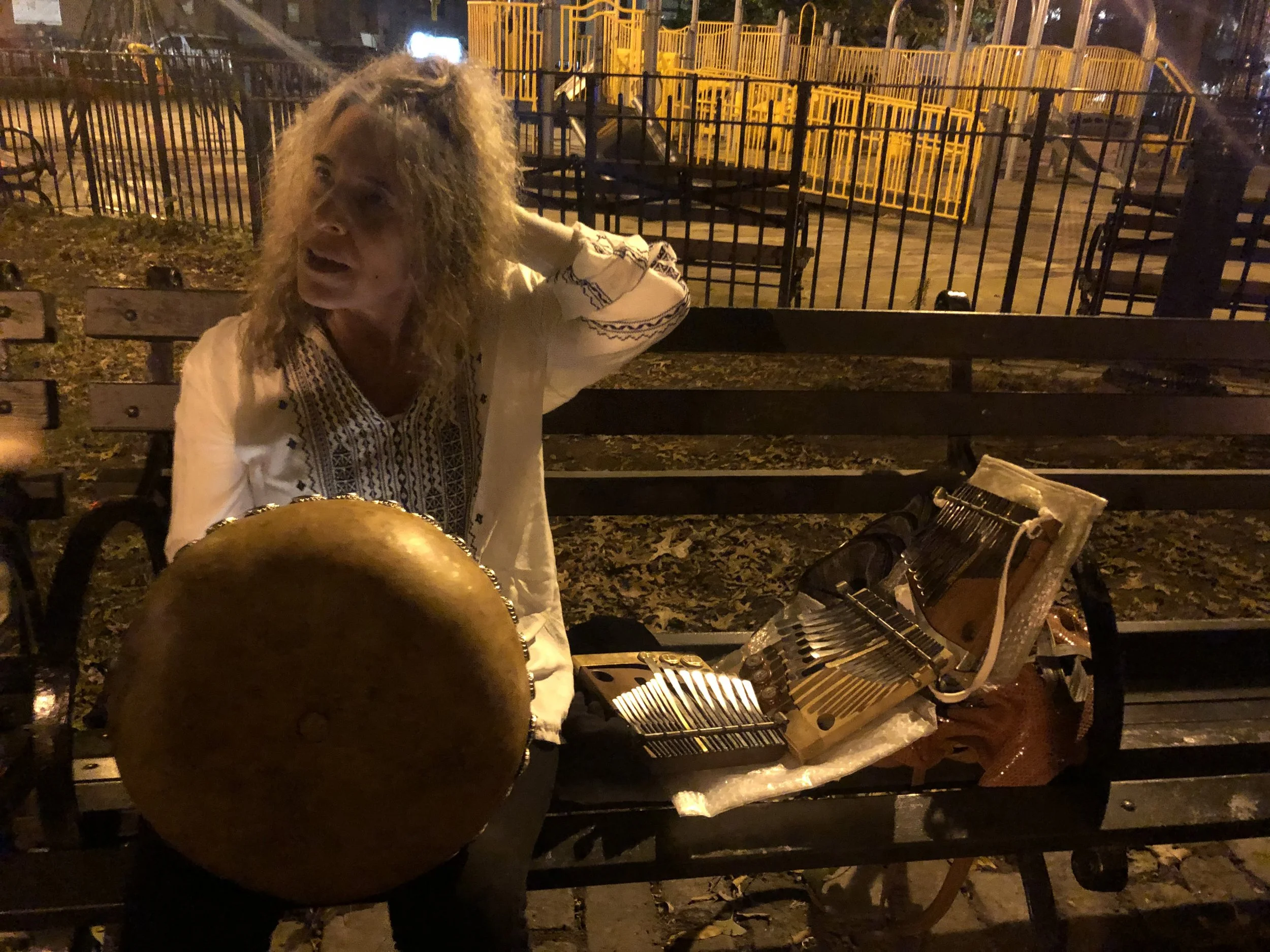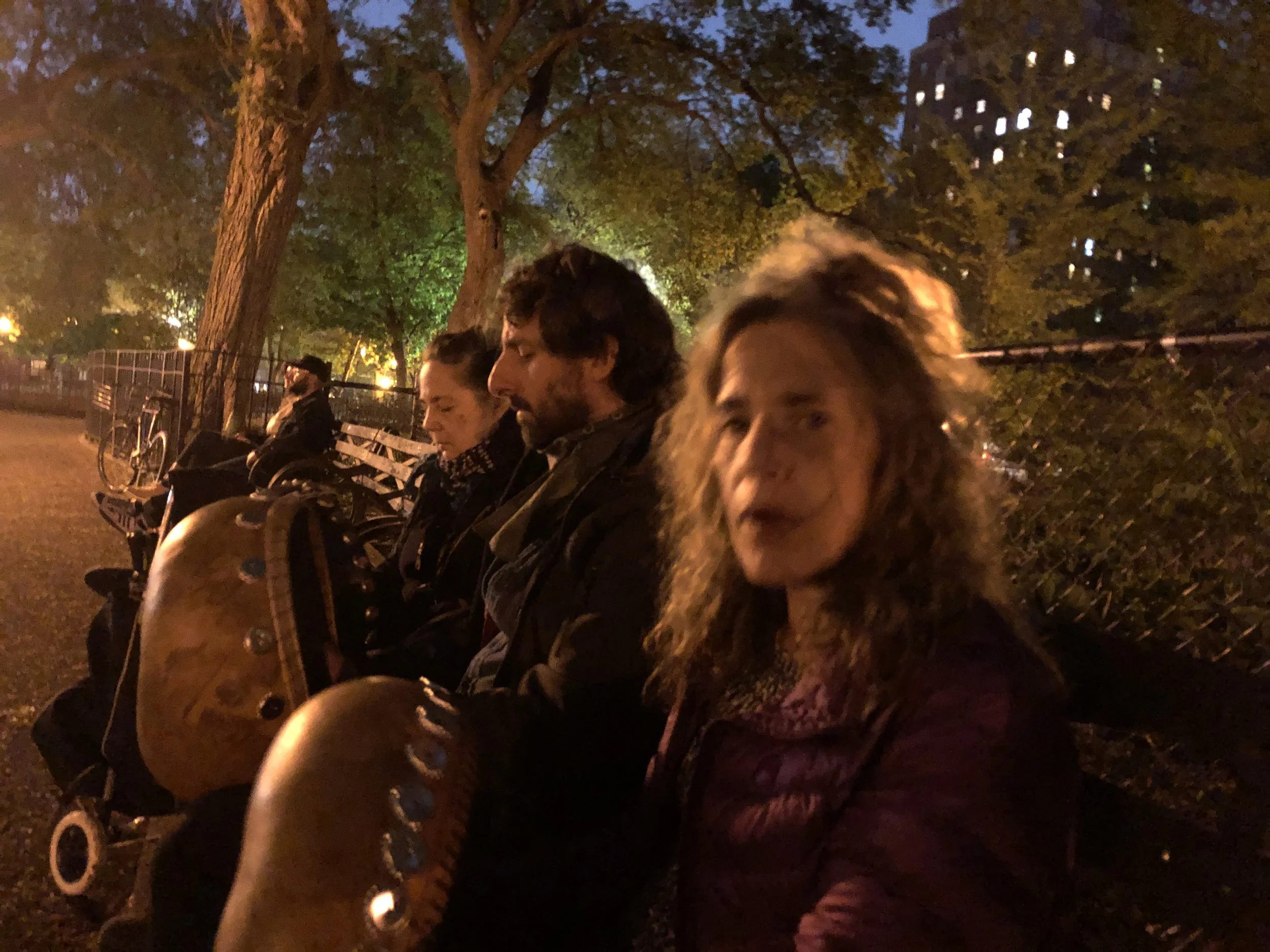
Originating in Manhattan’s East Village, MAPUTI came together during the pandemic, when a group of like-minded musicians began gathering every Tuesday in Tompkins Square Park to relieve the isolation of confinement.
As the COVID crisis subsided the band started to play in East Village venues, and street and community garden concerts, and increasingly, its individually-profoundly-committed-to-their-musical-practice members became involved, attending Zimbabwean music workshops, performing with visiting artists, and rehearsing regularly and gigging often.
So began MAPUTI. Elements came and went and eventually, this particular combination of people coalesced, all united by love and respect for the mbira, its culture, people, and the continent from which it sprang.
They are Nora Balaban and Susan Rapalee who play mbira and sing; Rima Fand plays violin and sings; Sylvain Leroux plays the qromatica (chromatic Fula flute) and sings, Nari Emeline Cerman Zechman plays djembe and sings; and her father Stuart Zechman plays hosho (maracas).
Nora Balaban, mbira and vocals
Nora Balaban is a New York City-based musician and visual artist deeply immersed in the traditional music of Zimbabwe and Mozambique. She began her musical journey singing in the East Village rock band, Pop Decay, performing at iconic venues like CBGB’s and Max’s Kansas City. After relocating to San Francisco, she played marimba with the Zimbabwe-style dance band, Mapenzi. This experience sparked her passion for African music and led her to form Fuzz Factor, a pop-rock band that fused African marimba with rock elements.
Driven by a desire to deepen her understanding of African musical traditions, Balaban traveled extensively across the continent. She studied Timbila (Chopi xylophone of Mozambique) with renowned musician Venancio Mbande, Shona mbira of Zimbabwe with master musician Tute Chigamba and family, and Gyil (Ghanaian xylophone) in Ghana. These immersive experiences profoundly influenced her musical style and teaching.
Upon returning to New York, Balaban founded Tribal Soundz, a world music store in the East Village that became a hub for ethnic instruments, workshops, and performances. She continues to teach mbira, organize workshops and concerts featuring master musicians from Zimbabwe and Mozambique, and performs with her group Timbila, an "Afrodelic Xylo Pop Band" co-founded with Banning Eyre.
Balaban is also a visual artist, focusing on pen & ink as well as creating hand-stamped apparel. Her work has been exhibited in New York City, reflecting her deep commitment to cultural exchange and artistic expression.
Susan Rapalee, mbira and vocals
Susan Rapalee is a Brooklyn-based musician and designer deeply involved in African and diasporic music since the early 1990s, beginning with training in the drum styles of the West African djembe orchestra and the drumming and singing repertoire of the sacred batá drums of the Yoruba tradition in Cuba, as well as other Afro-Cuban folkloric genres coming from the cultures of Congo and Dahomey. She has worked with a number of NYC groups presenting Cuban folkloric and ritual music on stage and in ceremony, and is a long-time member of Oyu Oro Afro-Cuban Experimental Dance Ensemble, with whom she has performed throughout the US and in Havana and Santiago de Cuba.
Susan’s love affair with the mbira further expands her knowledge and understanding of African music and culture through exposure to Zimbabwean mbira masters who come to the US to teach. She enjoys the challenge of riding the rich, intertwining polyrhythms of the mbira lines while singing in Shona and appreciates the communal and participatory aspect of mbira music.
Susan has also performed for the past two decades with several women’s percussion and vocal ensembles presenting musical traditions from the African continent, the Caribbean and the Americas and is currently active with Women Of The Calabash founded in 1978 by Madeleine Yayodele Nelson.
Rima Fand, violin and vocals
Rima Fand is a Brooklyn-based composer, musician and educator. An innovator who is also strongly drawn to folk traditions, she creates on an edge where the traditional meets the experimental. As a violinist she has explored the folk music of Appalachia and the Balkans in various creative musical ensembles, and a decade ago fell in love with the profoundly inspiring Shona mbira music, leading her to travel twice to Zimbabwe to study with mbira masters. As a composer she has created music for performances ranging from puppet theater to outdoor spectacle to tableau vivant to contemporary musical theater to clown shows. And she is currently composing her first opera, entitled Precipice, which will premiere at La Mama in the Prototype Festival in Jan. 2026.
Sylvain Leroux, qromatica and vocals
Sylvain Leroux is a Montreal-born, New York City–based multi-instrumentalist, composer, educator, and innovator renowned for his mastery of the Fula flute (tambin), a traditional three-holed flute from Guinea. He has been a pivotal figure in bridging West African musical traditions with jazz and contemporary music. Recognizing the instrument's limitations in playing chromatic scales, he innovated a modified version called the “qromatica,” enabling it to perform Western music's full range.
Nari Emeline Cerman Zechman, djembe and vocals
Nari Emeline Cerman Zechman is a New York City musician who has only recently joined Maputi in the fall of 2024. Here is her story, as told by her:
“I met Nora Balaban at Village Works, an East Village gallery and bookstore, when I was 10 years old, and it was she who first showed me an mbira. Hearing it for the first time, the mbira, its bell-like, yet rattling tones reminded me of an impossible cross between a marimba and a Rickenbacker bass, the interlocking parts enchanting me. I became deeply interested in mbira music, attending classes and workshops by Professor Jennifer Kyker to learn more about it. I fell in love with the sound of the mbira, the multilayered harmonies, and the driving rhythms of Shona traditional music as interpreted by Maputi. Discovering that audience participation is typical and encouraged in the Zimbabwean folk tradition, I brought my djembe to their concerts and played along with the ensemble. Eventually, after being invited to the stage, I was allowed to join Maputi, and now rehearse with them every week. I am essentially apprenticed to the band, which has helped me greatly on my musical journey.”
While not playing percussion, singing, and learning with Maputi, Nari plays bass, guitar, and drums in the rock genre with her band Mixolydian, studies voice with Kate Victor, and studies jazz drums, recording engineering and music production with Alex Goldberg. Though young, she is serious about music and believes that she can contribute to the artistic world.
Stuart Zechman, hosho
Stuart Zechman began clapping along with Maputi when taking his daughter Nari Emeline to rehearsals. He participated in classes and workshops with Professor Jennifer Kyker to build his skills. He learned to play hosho with the band and rehearses with them regularly, using his rhythmic concentration to maintain a steady tempo during the transformation and overlapping of the arrangements. He enjoys the technical challenge of attempting to remain aware of all of the mbiras’ rhythmic intricacies whilst still communicating intensity and purpose through the hosho, shaker, and hand clapping.







